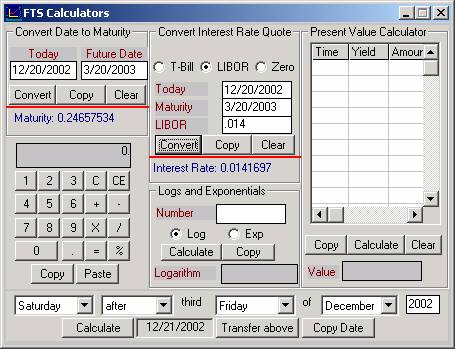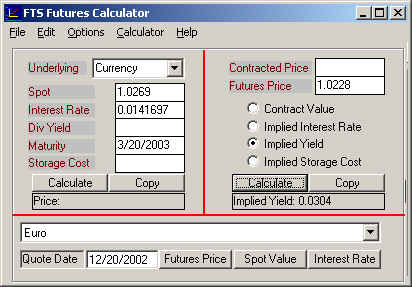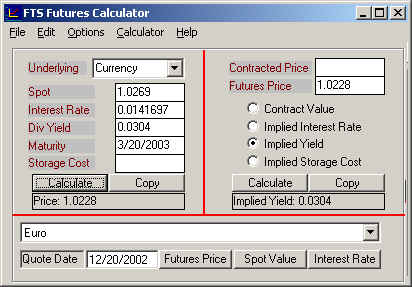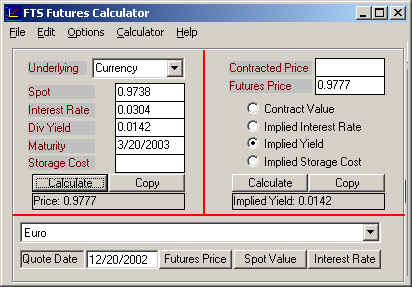![]() Example 3:
Computing Implied Foreign Rates from a Currency Forward Price
Example 3:
Computing Implied Foreign Rates from a Currency Forward Price
The
objective of the following exercise is to illustrate how the covered interest
rate parity theorem applies to the real world markets. In this application we will apply the FTS
Futures Calculator to infer the Euribor (or Eibor as it is also referred to)
which is the euro benchmark in continental
Consider
the following data:
On
Spot Rate
(USD/EUR (Currency in USD)): 1.0269
30 Day
Forward 1.0254
60 Day
Forward 1.024
90 Day
Forward 1.0228
Spot Rate
(EUR/USD (USD in Currency)): 0.9738
30 Day
Forward 0.9752
60 Day
Forward 0.9766
90 Day
Forward 0.9777
Money
Rates: Late
1
Month 1.4%
3
Month 1.4%
6
Month 1.46%
12 Month
1.51%
Question:
What are the implied Euribor rates (in continuously compounded form)
given the above currency forward rates?
To answer
this question we apply the covered interest rate parity relationship to the
spot and forward markets using LIBOR as the USD offshore deposit rate and solve
for the implied Euribor offshore deposit rates.
Step 1: Launch the FTS
Futures Calculator from the virtual classroom and select Calculator
from the menu items as illustrated below.

We first
convert the USD LIBOR to continuously compounded form. Select LIBOR and enter the 3-month spot LIBOR
rate as a decimal and then click on Convert.
The implied continuous compounded rate is provided as follows
(0.0141697):

Step 2:
Launch the FTS Futures Module from the Virtual Classroom and enter the
following information:
Remark:
You can enter dates directly or you can enter the date as a decimal time
to maturity. The decimal time to
maturity can also be calculated using the FTS Calculator in step 1 if you want
to. This is not necessary, however,
because the date can be entered directly as illustrated below:
Important Note: When applying the Cost of carry model to solve for the
currency forward price or an implied input, there are two interest rates
required. The domestic rate and the
foreign rate. However, domestic and
foreign rates are relative terms and so the “domestic rate” is the cost of
financial carry in the currency the price is measured in. This is because the synthetic forward
requires borrowing in the currency the price is measured in at the domestic
rate, converting at the spot rate and depositing at the other rate of interest. As a result, the “foreign rate” is equivalent
to a dividend from this deposit. In the
FTS Futures Calculator the dividend yield is the foreign rate of interest for a
currency forward.
Required
Inputs to Calculator to Solve for the Implied 90-day Euribor rate of interest
(continuously compounded).
Spot Rate
(USD/EUR) 1.0269
USD LIBOR
rate (90-days continuously compounded)) 0.014697
Quote date
Screen 1:
Entering dates (Quote Date and Maturity Date (alternatively you could
enter the decimal time to maturity beside maturity if you want to) directly,
and solving for the implied foreign rate (Dividend Yield) directly. In the right hand side of the screen click
beside Implied Yield:

Screen 2:
Verifying that the implied foreign rate supports the observed market
price of 1.0228. To do this in the
screen below we will enter 0.0304 directly beside the Div Yield and then
calculate the price by clicking on Calculate.
You can observe the answer is provided on the left side of the screen.

Step 3:
Interpretation
Observe
that covered interest rate parity relationship implies that the forward points
must favor the USD because interest rates are lower in the
i.
Deposit $1 at USD LIBOR
for 90–days, or
ii.
Convert $1 at the spot
exchange rate (= EUR/USD euros), deposit at Euribor (1+Euribor*90/360) for
90-days and at the same time enter
into a 90-day forward contract to convert (EUR/USD*(1+Euribor*90/360) Euros to
USD in 90-days.
Both i.
and ii. can be executed at the same time and both result in USD at the end of
90-days. As a result, both should result
in exactly the same number of USD to avoid creating an arbitrage
opportunity. But this implies that the
spot and forward rates must be consistent with the deposit rates for each
country. If the USD deposit rate is
lower than the Euro deposit rate then the forward rate must adjust so that the
USD is priced to appreciate against the Euro.
You can see this by contrasting the spot exchange rate (1 euro buys
1.0269 USD on December 20, but in 3-months time 1 Euro is exchanged at 1.0228
USD in the forward contract. That is, 1
euro buys less USD in 3-months time at this forward rate. The amount less exactly compensates for the
difference between the two 3-month deposit rates.
Step 4:
Additional Question: How does the way exchange rate are measured
matter?
To answer
this question we will repeat the above exercise by working with EUR/USD and
assuming that the 90-day continuously compounded deposit rate for the Euro is
0.0304.
In this
exercise the domestic rate is now the Euro rate (0.0304) and the foreign rate
(i.e., dividend yield) is the USD rate (0.0142). The right side of the screen computes the
implied Yield (which in this case is the USD Libor rate continuously
compounded) and in the Left side of the screen we enter this rate directly to
verify the forward price.

Thus it
does not matter which unit of measure you work with (i.e., USD/EUR or EUR/USD)
so long as you are consistent in the application of the inputs.
(C) Copyright 2003, OS Financial Trading
System